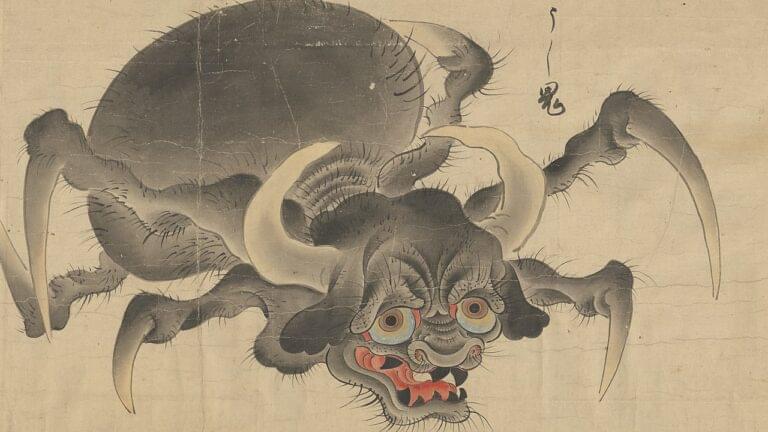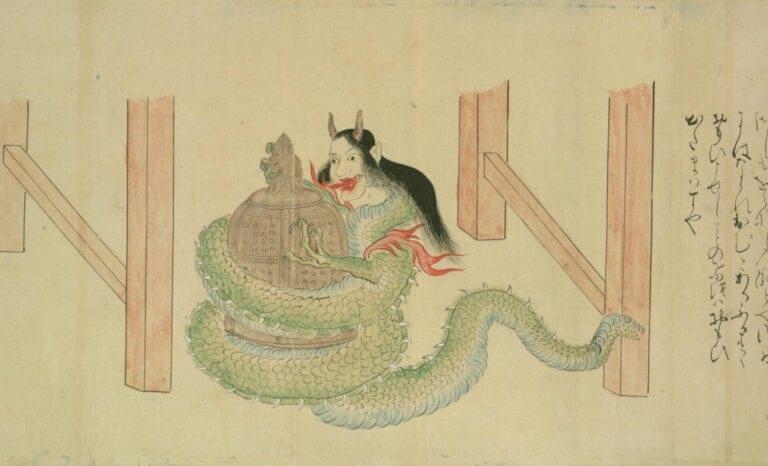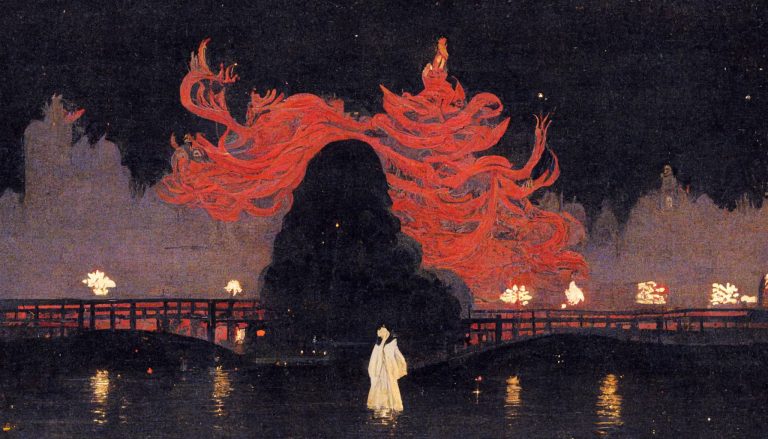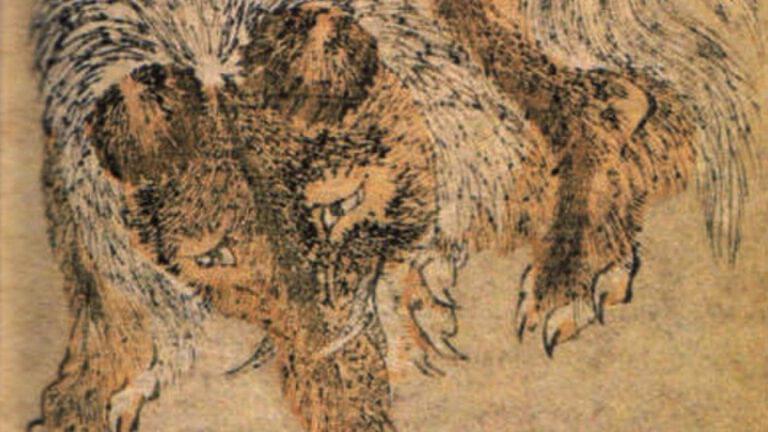My name is Thersa Matsuura and you’re listening to Uncanny Japan.
Boy was I surprised when I woke up the other day to see the American corner of the internet losing its collective mind about the 2024 joro spider invasion of New York City. A lot of “burn them with fire” stuff, too. But I’m here to tell you the joro spider, or joro gumo in Japanese, isn’t the demon spawn from hell that many think it is. I mean it is dangerous and deadly but not in the way you’re thinking. Oh, it also has connections to the gods
Let me explain.
Intro to Jorō Spider
I’m author Thersa Matsuura and this is Uncanny Japan, the podcast about yokai, folktales and some of the curious cultural quirks about Japan that I love so much. Today I’m going to tell you about the joro spider or joro gumo, a little about the real one, but a whole lot more about the beguiling mythical incarnation.
There’s actually a chapter on the Joro spider in The Book of Japanese Folklore that even has a fantastic drawing by Michelle Wang of a half spider, half kimono clad woman wistfully standing by a waterfall. It’s dreamy!
First Time Meeting Jorō Spider
Ok. I’ve been a big fan of this cuddly arachnid for a couple decades now. Both the insect and its mysterious yokai manifestation, too – yes, you’re going to love the darker side of this eight-legged enchantress. New York and those southern States it’s already infiltrated might be in a whole lot more trouble than they even imagined.
I first learned about it this colorful creeper the first time I came face to face with one. And when I say face to face, I’m not exaggerating. It was late summer/early fall back in the early 90s, and while on a walk I smelled magnolias. A fragrance that immediately took me back to my grandparents’ old farm house in Mississippi. I was so overcome with nostalgia that I promptly moved to bury my face in the magnolia bush and get a better whiff. When suddenly my friend grabbed me by the shoulders and yanked me back.
Before I could ask “what the?” they pointed to the enormous spider with black and greenish-yellow stripes on its plump body, and a little splash of red to ramp up the danger quotient. Had my friend not noticed or not managed to stop me, you and I would not be talking right now. Cardiac arrest right then and there. I’m sure of it.
Ever since then, though, I’ve kept my eyes peeled and I’ve learned quite a bit, even some very fascinating legends involving these eight-legged beauties.
The Real Spider
Okay, first, yes, the joro gumo is a real orb weaving spider. They’re very stunning to look at, bright yellow or yellow-green and dark blue or black-looking stripes on their bodies, sometimes with a touch of red. Nature does not want you to touch them. They don’t hop playfully around like a jumping spider, or do an exotic dance like the peacock spider and they’re not furry like a tarantula.
But they are pretty and they’re not dangerous. In Japan they usually appear in the fall and they like to weave nice big webs. You wake up one day and they’re everywhere. But despite that, plus three decades of living here, I’ve never heard of anyone ever being bitten by one.
I guess they can, but it’s very rare. I’ve read that even if you are bitten, the venom is weak and it’ll be something like a bee sting if that. They’re actually shy little ladies and their coloring pretty much says leave me alone, so if you do that, you’ll be fine. Also, don’t stick your face into random bushes either. But that’s probably just good sense right there.
The Male Spider
Another fun thing about them is if you look carefully at their webs in the fall, you can sometimes see the male spider, all super tiny and brown just waiting for some affection from his blushing bride.
Speaking of the bride, let’s move into the more legendary iteration of the joro gumo because here things really get wild.
What’s in a Name?
Let’s start with the name. I have to admit that when I was first told what they were called, for years I thought the name meant “watering can spider” because a watering can is joro in Japanese. Not the brightest cookie in the toolshed here. Remember I shoved my face into a web once. The spider’s name actually has an elongated last syllable, jorō. Not joro.
I eventually learned the joro in jorogumo fits better with its captivating personality. Jorogumo means Harlot Spider. Oh, but it gets better. The colorful creeper actually has two names. They sound the same, but have different kanji characters and different meanings.
The one most people use here (where I live at least) is Harlot Spider. The second is translated something like: Entangling Bride Spider. That’s where the bride segue comes in.
The Yōkai Version of the Spider
I have more to say about those names, but first let’s get into the origin of these charming silk spinner’s second identity, the yōkai jorogumo.
Imagine an older Japan where tucked away in the mountains there were magnificent waterfalls cascading into clear pools, all surrounded by lush trees and colorful wildflowers, birds chirping, bees buzzing, you get the picture.
And back then, humans had yet to even set eyes on these hidden paradises scattered all across the country. But that didn’t mean they weren’t occupied. The word was that enormous spiders lived there and acted as messengers to the gods or more specifically the water deities. Everything was in accordance with nature. That is until people arrived.
That’s when things went wrong.
So what is a giant peace-loving spider to do when humans start horning in on their sacred spots?
Lunge at the intruder with dripping fangs? Snatch them up and wrap them in a tight cocoon of sticky spider silks? Loom overhead and shoot venomous hairs causing paralysis?
Nope, nope, and nope. What they do do is turn into a beautiful kimono-wearing woman and work from there. There are many tales of these bewitching creatures from different parts of Japan. I tell one in The Book of Japanese Folklore, but here let me tell another one.
It’s a different version of the one I wrote about in the book and it demonstrates well the hypnotic and dangerous power of the spider.
Keep in mind that by this time certain waterfalls were believed to have a jorogumo living there. Sometimes they were called weaving pools because you could hear the sound of a loom, the spider making her web. Anyway, it was advised you not visit one of these harlot spider-inhabited waterfalls, but some people (like the protagonist in the following story) just didn’t listen to local wisdom.
A Story About the Jorōgumo
Once upon a time, a woodcutter visited the idyllic Joren Falls. While there he met a beautiful woman. The two talked and surprise surprise he fell helplessly in love. He returned the following day and the day after that.
In fact, he began visiting the area every day. Nothing could stop him from going. But after a while, he started falling ill, getting weaker and weaker. His friends and family noticed and consulted the local monk who rightly suspected a jorogumo was the culprit.
The next day, when the woodcutter set off to visit the waterfall, the monk accompanied him. Once there, the holy man began reciting sutras in order to break the spell the harlot spider had cast. As he chanted, though, a silky thread stretched from the bottom of the falls and attached to the woodcutter. The monk, seeing this, shouted loudly interrupting the bewitchment. The thread vanished.
But the woodcutter was still in love. There was no changing that. Even knowing now that it was a joro spider that had charmed him, he couldn’t give her up. So, he went to the tengu who lived on that particular mountain and he asked its permission to marry the mysterious web spinning beauty. That would solve his problems, he thought. But the tengu, knowing the danger, refused and also warned him of her magic.
And yet the woodcutter still did not give up. As a final act of demonstrating his love, he ran headlong toward the waterfall where he was caught up in the spider’s threads and pulled into the plunge pool where he disappeared, never to be seen again.
Different Meanings of Her Name
Remember I said jorogumo can be read as harlot spider or entangling bride spider? It looks like this comes from the artist and storyteller Toriyama Sekien’s depiction. In his collection: Gazu Hyakki Yagyō or Illustrated Demon Horde’s Night Parade (1776) he has a chapter on her. In the table of contents, he writes her name with the entangling bride characters, but in the chapter itself, he uses harlot spider.

I’ve found some who say the name used, depends on her form. If a gorgeous femme fatale, she’s an entangling bride. If a giant arachnid, harlot spider. It was Toriyama Sekien who created the classic image of her (at least in my opinion). It shows the back of a woman who is wearing a kimono, but apart from her long hair, you can see six hairy legs sticking out. Presumably she’s standing on the other two.
Can They Fly? Or Can they Balloon?
This brings me back to the real spider for a second. Another thing I read that everyone was upset about when talking about the New York Jorō Spider Invasion is that the babies can fly. No, the babies can’t fly. But there is something they can do that’s a whole lot more fun, and possibly disturbing. There’s a thing some spiders do called ballooning which is adorable if you think about it.
The little ones will release some silk thread from their spinnerets into the air until the length and wind conditions are just right – usually a warm day with a light breeze and some rising air currents called thermals – and when all that aligns, the spider becomes airborne. Wee! Carried away by the wind like a tiny little spider balloon. Hence the name. Ballooning.
I’ve never seen this, although, come to think of it, I often get covered in stray spider gossamer silks on my walk near the river. Which I just thought was annoying. I never considered there might be wee spideys attached to the end of those strings.
Anyway, the reason I found this ballooning super interesting is that if you look back at Toriyama Sekien’s picture of the jorogumo, she looks to be flinging a single thread from each of her six hairy spider legs. And at the end of every one of those strands is a BABY SPIDER! So even back in the 1700s, ballooning was observed and Toriyama-sensei depicted it.
What Else Can They Do?
But there’s more! In the image, those baby spiders are spitting out fire from their tiny mouths. Which gives a nice plot twist to the whole burn them with fire thing. Whose offing whom with fire. Be careful out there, everyone. Be nice, too. The joro spider wishes you no harm. Unless you go poking around her waterfall and start falling in love and stuff. Keep your face out of webs and if you see some wee eight-legged balloons floating along, just move aside and let them pass.
A Visit to the Jorōgumo
Also as a thank you to my editor and sound guy for his work on this show but also on finishing up the audio version of The Carp-Faced Boy which is almost done, I’m dragging Richard to Joren Falls the day after I record this. Yes, the same one I mentioned a few minutes ago and in the book. And, yes, I just said something about how some people don’t take the advice of wise folk and stride confidently into the ‘find out’ stage of things. But from someone who has been known to make dubious choices in life, I’m so very curious.
It’s just a two-hour-drive from here and we’re in dire need of a getaway. The weather looks nice, so, patrons, I’ll be posting photos and video and some waterfall soundscapes for some exclusive patron-only content for you all soon. What if we meet some ethereal beauty there? What if only one of us comes back? Oh the drama!
Thank you so much for listening. Everyone, stay safe and well. No burning spiders with fire because you never know if they’re just a timid mosquito eater, a lovely lady in disguise, or they might not just turn around and spray the fire right back.







thank you!! i’m using some info here for a spider-man AU fanfiction with one of my fav charas so yahh :3
Oh, awesome! That sounds like a wonderful pairing. Best of luck!